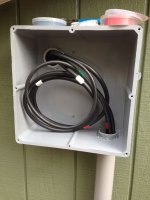1" conduit seems awful small to me. I normally do 1.5" minimum, or 2", but it actually depends on the wiring gauge, wiring jacket, and ampacity, so check the code/specs to be sure it's all correct. You always need to have a certain amount of air space in a conduit per code.
Depending on the wiring and how it may transition, I have run conduit into a building in a couple ways.
If you have access under the wall or under the footing, or can bust through the wall/footing below the soil level, just run the conduit directly into the building and up the interior wall. Easy to do prior to pouring a slab in barns, maybe not so easy in other scenarios.
For all other cases, I run conduit from ground up the side of the exterior wall and attach it (via threaded threaded adapter) to a junction box mounted on the exterior wall (and caulked/sealed to the siding to be protected from weather). There are various sizes of gray PVC junction boxes that you can use. For my generator shed I used a 12x12x8" box, in other cases I have used 6x6x4" box. You can cut holes in the box as needed to attach conduit.
Then from that junction box, run through the wall. If using jacketed wire rated for plenums, such as Romex, you can simply drill a hole. For single conductor wires, you need to have conduit. A short section of conduit with nuts on each end can join the exterior junction box with your interior box, be it a breaker panel, load center, other junction box, etc.
I attached a photo of one such arrangement where the box on an exterior wall was simply used as a transition and a place to contain a slack loop of cable (I love to have slack in strategic places for future work, if something needs to be repaired or swapped out). This is on my generator shed, and that is 1/0 aluminum XHHW wiring. That particular wiring was run continuous from home to load center in the generator shed -- on the other side of the junction box is a load center with a single 100A breaker. Past that, the wiring transitions to fine strand copper to properly handle vibrations when attaching to the generator.

If you happen to be joining different wire types, the exterior junction box is a good place to do that. For example, for my barn power line, I have #6 aluminum single conductor wires running underground, but it marries up with jacketed Romex copper to tie into my home's main breaker panel. The exterior junction box is the place where the two wire types meet up and connect. The box is a convenient, code-acceptable place to make the connection and gives you a lot of room to work. The box is sort of an intermediate meeting place where different types of wire (plenum rated Romex coming through the wall and single conductor XHHW coming from underground) can meet up and satisfy code in both ways. Even if using jacketed wire on both legs, say Romex for interior and UF from underground, the exterior junction box is a good place to tie them together.
A final benefit of the exterior junction box is that it lets you wire the project in stages -- just leave the unused ends of each leg of wire curled up in the junction box (and properly terminated as necessary) until you complete the wiring with other legs coming into the box.
